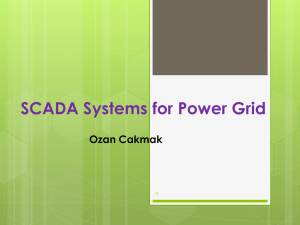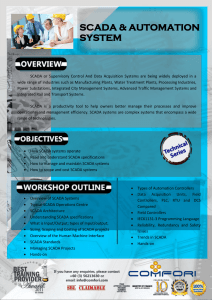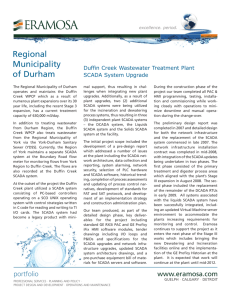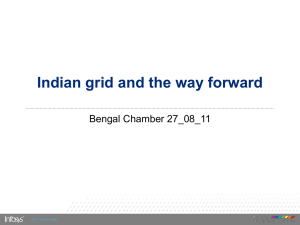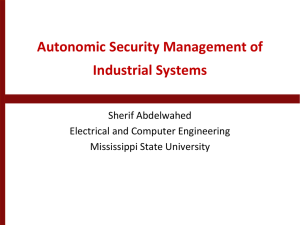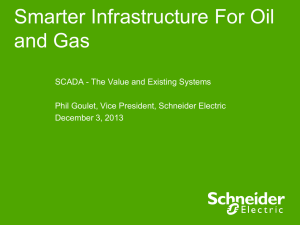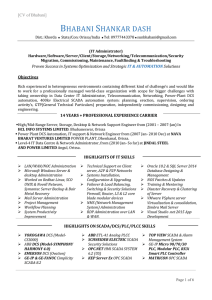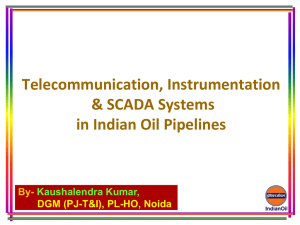Slide PPT
advertisement
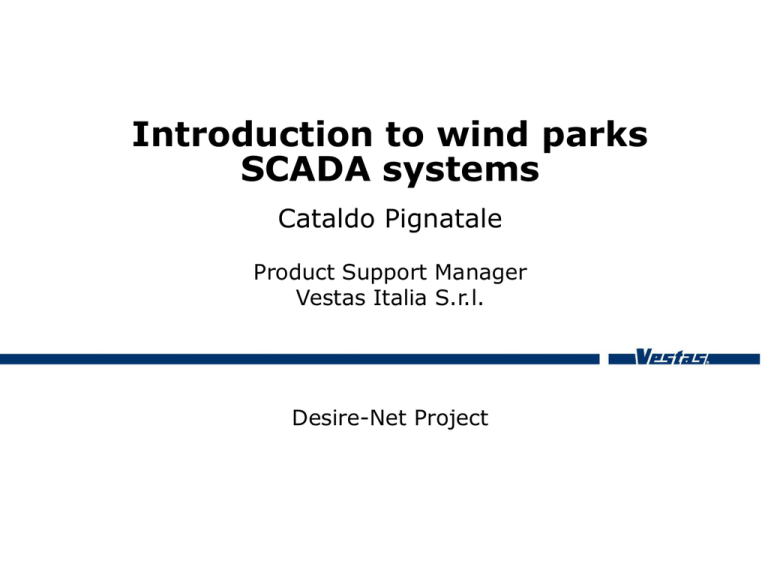
Introduction to wind parks SCADA systems Cataldo Pignatale Product Support Manager Vestas Italia S.r.l. Desire-Net Project Session Contents • Aim: at the end of this session participants will have a quick overview of the fundaments of a modern wind park SCADA system • Duration: 20-25min 2 Agenda • • • • • Basics Why a SCADA system Evolution Requirements SCADA components in wind parks 3 Basics 4 Basics Definition SCADA=Supervisory Control & Data Acquisition SCADA (Supervisory Control And Data Acquisition) system refers to the combination of telemetry and data acquisition. It consists of collecting information, transferring it back to a central site, carrying out necessary analysis and control, and then displaying this data on a number of operator screens. The SCADA system is used to monitor and control a plant or equipment. Control may be automatic or can be initiated by operator commands. 5 Basics What is based on • The central SCADA master system. • A communications network. • The RTU's. Remote Telemetry (or Terminal) Units. • Field instrumentation 6 Basics DCS Similar to the SCADA systems are the Distributed Control Systems (DCS). The DCS is usually used in factories and located within a more confined area. It uses a high-speed communications medium, such as local area network (LAN). A significant amount of closed loop control is present on the system. The SCADA system covers larger geographical areas. It may rely on a variety of communication links such as radio and telephone. Closed loop control is not a high priority in this system. 7 Basics In the wind industry • Communication interface on the device that has to be controlled • Communication network • Communication concentrator • “Server” unit • “Client” unit • Man to machine interface 8 Why a SCADA system 9 Why a SCADA system? Wind turbines are made to operate unattended! Manufacturer point of view • Fulfill contractual obbligations on service & reduce service costs • Get feed-back for product development Operator/Owner point of view • Verify contractor obbligations • Reporting (various levels) • Integration of different windparks over the country 10 Why a SCADA system? External requirements • Wind power plant operation • Fulfillment of grid operator requirements • • • • Active power control Cooperation to reactive power control Balck-star connection Etc. • Forecasting tools 11 Evolution 12 Evolution Yesterday • Few status signals • Historical data processed at centralized level (raw signals collection) • Dedicated HW • Dial-up remote connection Today • WTG=IFD (Intelligent Field Device) • Historical data processed in the WTG • Commercial HW • Broadband connection (Point to many) 13 Requirements 14 Requirements Low demand systems • No external database • Rely on wind turbines internal memory (limited ammount of data) • No data back-up functionalities • Limited number of wind turbines to be connected • Impossible to connect devices other than windturbines • No customized features • Standard reporting 15 Requirements Professional systems • External database • Impossible data loss • Back-up functionalities • Unlimited number of turbines connected • Possible to connect devices other than windturbines (revenue meters, metereological stations, PLCs, etc) • Custom features available • Advanced and custom reporting available • High security • Possibility of interfacing other devices on several different protocols • Etc… 16 SCADA components for wind parks 17 Communication port • Hardwired I/O • Serial communication ports (RS232, RS485, Optical, etc.) • Ethernet Ethernet port Optic RS232 port 18 Communication Protocols • Proprietary • Industrial protocols (ModBus, DNP3,…) • Standardised protocols: IEC61400-25 19 Communication network • Serial • Copper wires • Optic fibres • Ethernet • Ethernet Location: Cabin near substation RB27 1:OVERVIEW 2003 jan 27 RUN - Power------Gen.----Rotor---Wind--- Pitch 1538 kW 1684 rpm 18 rpm 8.9 0.4 ° RB25 RS2FX/FX 1:OVERVIEW 2003 jan 27 RUN - Power------Gen.----Rotor---Wind--- Pitch 1538 kW 1684 rpm 18 rpm 8.9 0.4 ° RB24 RS2-FX/FX i 7 +24V Fault +24V* 6 FAULT P2 P1 Stand by RM 7 6 5 5 4 3 2 4 3 2 1 1 0 RM Stand by 1 RS2FX/FX V.24 Stand by RS2-FX/FX i 7 +24V Patch panel Fault +24V* 6 FAULT P2 P1 Stand by RM 7 6 5 4 3 2 1 1 0 5 4 3 2 RM Stand by 1 V.24 RS2FX/FX Stand by RS2-FX/FX i 7 +24V Patch panel Fault +24V* 6 FAULT POWERNET 1:OVERVIEW 2003 jan 27 RUN - Power------Gen.----Rotor---Wind--- Pitch 1538 kW 1684 rpm 18 rpm 8.9 0.4 ° POWERNET SERVER POWERNET 1:OVERVIEW 2003 jan 27 RUN - Power------Gen.----Rotor---Wind--- Pitch 1538 kW 1684 rpm 18 rpm 8.9 0.4 ° P2 P1 Stand by RM 7 6 5 5 4 3 2 4 3 2 1 1 0 RM Stand by 1 V.24 Stand by Patch panel Firewall ADSL Router 20 Communication concentrator • Multiplexer/modem • ISDN • PSTN • GSM Optional VPN Tunnels ISP • Router • Analog • ISDN • ADSL/xDSL/Satellite Analogue, ISDN, ADSL, FWA Internet Firewall ADSL Router ISP ISP Analogue, ISDN, ADSL, FWA 21 Server Device that manages the continuous collection of data from the units in the wind power plant. Eventually collected data are stored in a central database and used for operating and managing the wind power plant. •Dedicated HW •Host PC •Industrial servers 22 Client Device hosting the HMI (Human to Machine Interface), the operator's user interface for viewing instant data as well as accessing and processing the collected data from all units in the wind power plant as well as for viewing instantaneous data from the units. •Remote panels •Client SW hosted in PC 23 24
